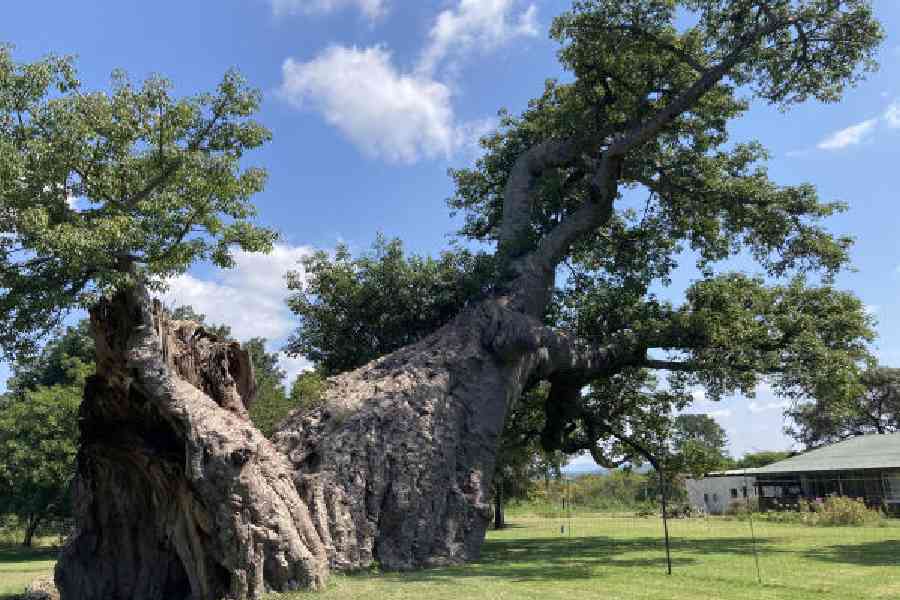Baobabs are arboreal icons that have punctuated Africa’s landscapes for around 12 million years. With crowns that can grow as large as three tennis courts, they are important for more than their role in ecosystems. The trees are featured in cultural traditions across Africa, and support the livelihoods of thousands of people who harvest baobab fruit.
And across mainland Africa, a researcher has argued recently, the trees are flourishing.
This finding offers a contrast with reports several years ago that Adansonia digitata, a baobab species that is widespread, was in serious jeopardy in the face of droughts and rising temperatures linked to climate change, with some of the largest baobabs collapsing. In 2018, researchers took note of the trees’ troubles in the journal Nature Plants.
This alarming news caught the attention of Sarah Venter, a baobab ecologist at the University of Witwatersrand in South Africa. She had not seen signs in her own fieldwork that Africa’s ancient baobabs were in trouble, so she decided to conduct her own investigation, which was also published this year in Nature Plants.
Venter found that five of the trees flagged in the 2018 paper had actually died, while the other 10 were healthy. Another 13 exceptionally large baobabs that Venter had visited in southern Africa also appeared to be doing well.
In a review of recently published literature, Venter showed that millions of baobabs populate the continent, including in areas that have endured severe droughts or floods. These findings suggest “there’s a very healthy population of baobabs across Africa”, she said.
Venter travelled around southern Africa to survey the health of adult baobab trees. She found a normal distribution of individuals, and no signs of out-of-the-ordinary disease or mortality. In one group of 116 trees that Venter has monitored since 1998, none of the adults died in the past 26 years, despite numerous droughts.
She also visited most of the exceptionally old and large trees included in the 2018 study. For the five trees that perished, she found that only one death seemed to be linked to drought. The other baobabs appeared to have died randomly, during periods of normal rainfall and temperature.
“Without being there during time of death, the exact cause cannot be said for certain,” she said. Most likely, though, their large, heavy limbs had fallen off, and the breaks had become infected.
Of five trees reported to have collapsed in the 2018 study, Venter found four were growing back. This was not a surprise, she said, because “it’s part of baobab ecology to collapse and grow out again from the stems that are left”. Drought driven by climate change did not seem to have contributed to those trees’ collapse either.
Jens Gebauer, a horticulturist at the Rhine-Waal University of Applied Sciences in Germany who was not involved in the research, agreed “that climate change is not the main cause for the old baobabs’ dying”. But things could change in the future, he added, because “the baobab cannot deal with excessive moisture, caused either by climate change or human activities”.
Karl von Reden, an oceanographer at the Woods Hole Oceanographic Institution, US and an author of the 2018 study, said the new paper’s findings that the trees had collapsed because of structural failure “sounds reasonable”. He added, though, that it “does not contradict the assumption that climate change is one of the important drivers of the observed effects”.
Venter maintained that climate change did not seem to be a major factor in baobab death. If it was, she said, then other large baobabs would also show signs of stress, “but that’s not what I saw”.
Baobabs do face other threats. Saplings struggle to survive in areas with high levels of livestock grazing. Trees growing in places with a high density of elephants can be imperilled because when the animals face food shortages, they will eat baobabs.
She stressed that for now, though, there is no reason to fear that mainland Africa’s baobabs will disappear. “It’s an incredibly resilient tree,” Venter said. “I think they’ve got a great future.”
NYTNS










